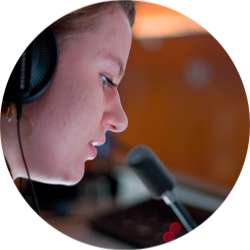
Here you will find some basic information on interpreting equipment.
It is in your interest to use standardised equipment and competent technicians both for installation as well as operation. We source equipment from several specialised suppliers of which we will pick the ideal partner for your event subject to an individual assessment of your specific requirements. We are also happy to advise you on the ideal number of booths, microphones and delegate headsets. If you prefer to commission your own partner, we will also be happy to work with them!
What do you need?
INTERPRETING EQUIPMENT (CLASSIC VERSION)
The basic system comprises one or more interpreting booths (one per language pair) including interior equipment, interpreting desks, a mixing console, a central unit, headphones and receivers for the participants as well as - if not available already - microphones for the speakers and a loudspeaker system.
Interpreter booths
For simultaneous interpreting, you normally need one booth per language. Booths should comply with ISO 2063 (built-in booth) or ISO 4043 (mobile booth).
The booths should be soundproof and have a silent ventilation system. This will ensure better communication and an undisturbed listening experience for the participants.
The following is important:
- Size: A mobile 2-person booth measures 1.60 m wide x 1.60 m deep x 2.00 m high.
- Location: The booths must be positioned in such a way that the interpreters have a clear view of the speakers and the screen on which the presentations are projected and thus can see the participants' reactions.
- Windows: The booths should be equipped with clear (non-tinted) glass or plexiglass windows one covering the front from table height to almost the top and one covering the front half of the side.
- Ventilation: each cabin must have a silent fan that normally fits into the roof at the rear, adequate lighting (small moving desk lamps) and adequate sound insulation.
- Do not forget comfortable chairs for the interpreters.
The price varies according to the composition which is completely modular.
If the available space is not sufficient for interpreting booths or if there are suitable ancillary rooms such as control booths etc., the system can be installed there and sometimes even without a physical booth. In this case, monitors are used to enable the interpreters to follow the proceedings on stage.
TOUR GUIDE SYSTEMS
For events with few participants tour guide systems are sometimes used instead of classic interpreting equipment.
Often used as a minor variant of interpreting equipment tour guide systems were originally developed to support guides in their work. Their suitability for interpreting assignments is limited and they often fall short of the promises made by providers and the expectations of customers. They basically consist of a microphone for the interpreter and headphones with a built-in receiver unit for the listeners with everything transported in a single case.
Advantages:
- Flexibility in use: Whispering systems are independent of locations and easy to transport. They fit into a briefcase and are ideal for assignments on the move such as guided tours.
- With a small number of listeners, the price is lower than that for interpreting systems.
- Since the interpreters have only one microphone, they take no extra space and the interpreters can be placed (almost) anywhere.
- Tour guide systems are a cheap option for short assignments with few participants, but then again cheap in every respect.
Disadvantages:
- The transmission quality of tour guide systems is not comparable with that of classic interpreting equipment.
- The interpreters sit in the same room as the listeners without a booth. This means that their voices are audible to all those sitting around them, which is often perceived as annoying. In addition, the situation also affects the interpreters' concentration who are unable to concentrate fully.
- The interpreters do not receive the sound through headphones, but rather pick it up from the normal room volume. This impairs concentration so that translation is less complete.
- The lower price is partly due to the fact that tour guide systems usually come without the support of a technician familiar with their frequent hickups and able to sort them directly on the spot. This means, however, that there is also no-one available to intervene should this be necessary.
- Tour guide systems are more susceptible to faults than real interpreting equipment.
- WhTour guide systems are not suitable for events with many participants.

